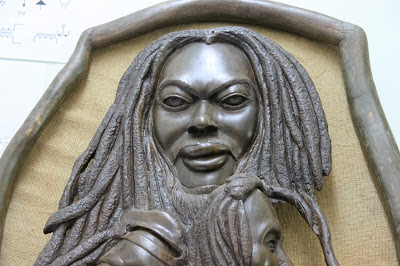Rastafari Exhibition: The Spiritual Self Journey
Life, it is said, comes in hues, brings perspectives and is a continuous journey of self-discovery.
Walking into the circular bamboo tabernacle, the thatched roof, mud floor at the Institute of Jamaica (IOJ), Kingston, one is transported into such a voyage of revelation.
The temple of the Most High begins with the body which houses our life, the essence of our existence, Emperor Haile Selassie I once said - the tabernacle encapsulating and resonating his voice.
The tabernacle, like a focal point, was being set up with other artefacts, as the stage was being set for an exhibition on the culture of Rastafari.
"It (the exhibition) aims to educate the Jamaican and international community on Rastafari, which is an important aspect of our cultural heritage," said Makebe Trott, assistant curator at IOJ.
"Among areas explored are the revelations of Rastafari, the philosophy and evolution of the Rastafari movement, as well as a historical review of the tribulation and atrocities experienced by members."
Trott said that one of the primary objectives of the Rastafari exhibition was to put things into perspective and demystify some of the perceptions and misconceptions about Rastafari culture.
"Focus will also be given to the pioneers and 'imples' (disciples) of Rastafari, Mansions, and Rastafari 'livity' (way of life)," Trott said.
Through the rustic, nature-inspired and spiritually connected pieces of art, worship, and music, Trott said the exposition would "highlight the contributions of Rastafari to the Jamaican society and the world, while at the same time revealing the response of the Jamaican society towards the movement."
"It is a journey to find the self," Trott said.
reaching to the sacred
The genesis, trials, and tribulations - sacred and pious - respecting the supreme being and nature, resonates in the art pieces.
Trott said that one of the primary objectives of the Rastafari exhibition was to put things into perspective and demystify some of the perceptions and misconceptions about Rastafari culture.
"Focus will also be given to the pioneers and 'imples' (disciples) of Rastafari, Mansions, and Rastafari 'livity' (way of life)," Trott said.
Through the rustic, nature-inspired and spiritually connected pieces of art, worship, and music, Trott said the exposition would "highlight the contributions of Rastafari to the Jamaican society and the world, while at the same time revealing the response of the Jamaican society towards the movement."
"It is a journey to find the self," Trott said.
reaching to the sacred
The genesis, trials, and tribulations - sacred and pious - respecting the supreme being and nature, resonates in the art pieces.
"Rastafari goes beyond Pan Africanism by being a universal liberation movement, concerned with all oppressed peoples of the world," Trott said.
Rastafari is a spiritual/faith-based movement which declares His Imperial Majesty, Emperor Haile Selassie I (Ras Tafari Makonnen) as the manifestation of the Holy Trinity or the Almighty.
"His Imperial Majesty, Emperor Haile Sellassie I, Leonard P. Howell, and Marcus Garvey, among others, provided the platform and tenets upon which Rastafari operates," she said.
Showcasing the richness of the Rastafarian way of life, the terms 'peace and love' and 'one love' are prominently highlighted in the space.
"(These terms) embody Rastafari recognition of the basic human rights of all.
"Rastafari emphasises self-love and awareness through the reconnection with one's roots, [and], more specifically, Africa," Trott said.
Rastafari is a spiritual/faith-based movement which declares His Imperial Majesty, Emperor Haile Selassie I (Ras Tafari Makonnen) as the manifestation of the Holy Trinity or the Almighty.
"His Imperial Majesty, Emperor Haile Sellassie I, Leonard P. Howell, and Marcus Garvey, among others, provided the platform and tenets upon which Rastafari operates," she said.
Showcasing the richness of the Rastafarian way of life, the terms 'peace and love' and 'one love' are prominently highlighted in the space.
"(These terms) embody Rastafari recognition of the basic human rights of all.
"Rastafari emphasises self-love and awareness through the reconnection with one's roots, [and], more specifically, Africa," Trott said.
How these facets of the Rastafari lifestyle are presented, the assistant curator said, is critical. There is a particular order, according to the different mansions, in which paintings, utensils and artefacts are placed. The red, gold and green of the faith and the 'Lion of Judah' are interspersed throughout.
The larger-than-life presence of His Imperial Highness towers the space, showering his blessings to the space - resonating his teachings, and way of life. "Man cannot live by bread alone," Haile Selassie I said, "Man, after all, is also composed of intellect and soul. Therefore, education, in general, and higher education in particular, must aim to provide, beyond the physical, food for the intellect and soul ... the Rastafari Exhibition aims to nurture that intellectual and spiritual energies."
The Institute of Jamaica in collaboration with the Rastafari community invites the public on July 21 to view the ongoing development of the Rastafari Exhibition at the Water Lane Gallery.
The larger-than-life presence of His Imperial Highness towers the space, showering his blessings to the space - resonating his teachings, and way of life. "Man cannot live by bread alone," Haile Selassie I said, "Man, after all, is also composed of intellect and soul. Therefore, education, in general, and higher education in particular, must aim to provide, beyond the physical, food for the intellect and soul ... the Rastafari Exhibition aims to nurture that intellectual and spiritual energies."
The Institute of Jamaica in collaboration with the Rastafari community invites the public on July 21 to view the ongoing development of the Rastafari Exhibition at the Water Lane Gallery.







Comments
Post a Comment